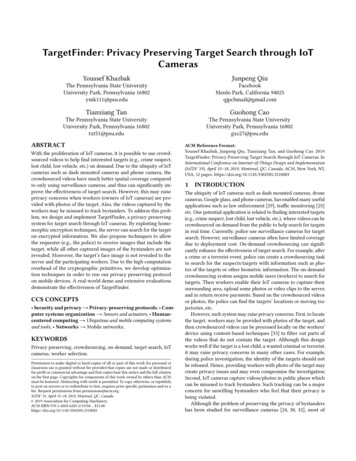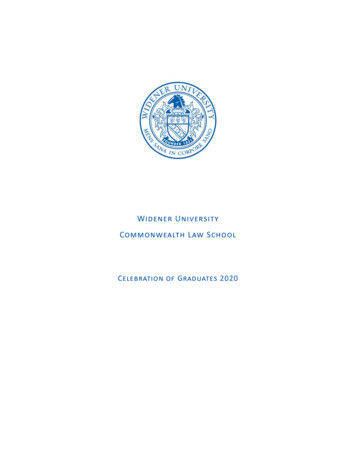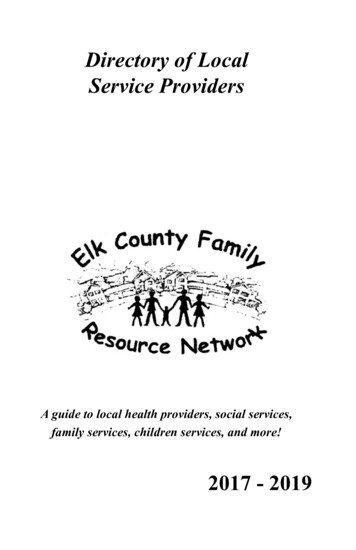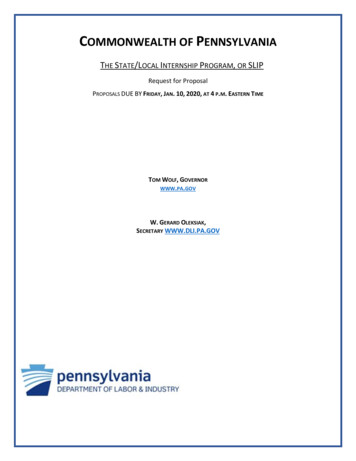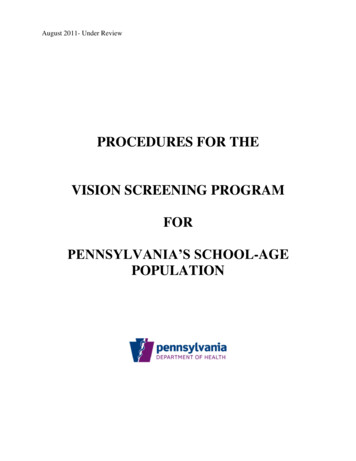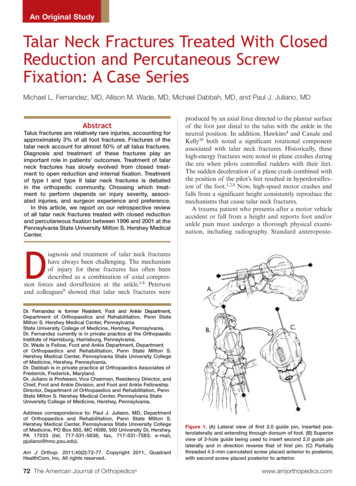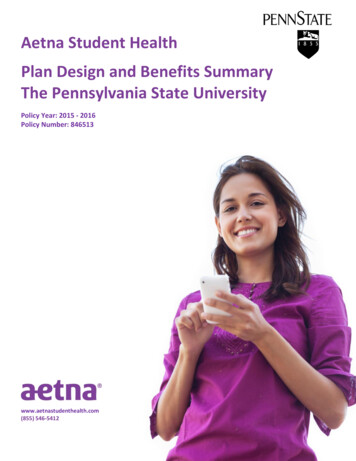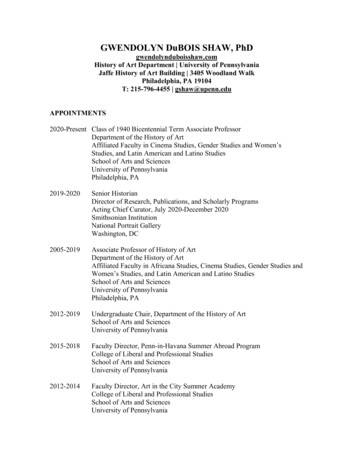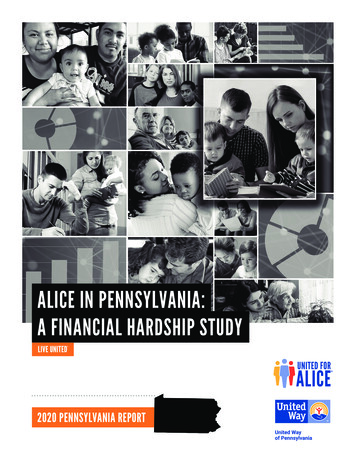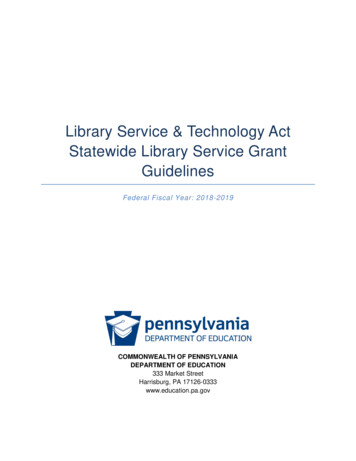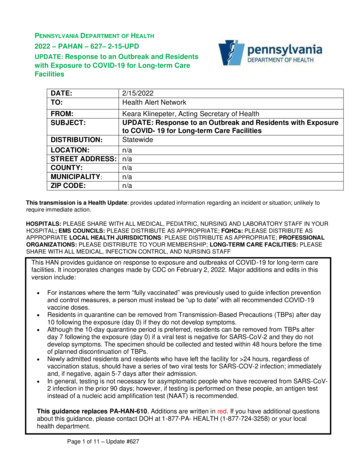
Transcription
PENNSYLVANIA DEPARTMENT OF HEALTH2022 – PAHAN – 627– 2-15-UPDUPDATE: Response to an Outbreak and Residentswith Exposure to COVID-19 for Long-term CareFacilitiesDATE:TO:2/15/2022Health Alert NetworkFROM:SUBJECT:Keara Klinepeter, Acting Secretary of HealthUPDATE: Response to an Outbreak and Residents with Exposureto COVID- 19 for Long-term Care FacilitiesStatewideDISTRIBUTION:LOCATION:n/aSTREET ADDRESS: n/aCOUNTY:n/aMUNICIPALITY:n/aZIP CODE:n/aThis transmission is a Health Update: provides updated information regarding an incident or situation; unlikely torequire immediate action.HOSPITALS: PLEASE SHARE WITH ALL MEDICAL, PEDIATRIC, NURSING AND LABORATORY STAFF IN YOURHOSPITAL; EMS COUNCILS: PLEASE DISTRIBUTE AS APPROPRIATE; FQHCs: PLEASE DISTRIBUTE ASAPPROPRIATE LOCAL HEALTH JURISDICTIONS: PLEASE DISTRIBUTE AS APPROPRIATE; PROFESSIONALORGANIZATIONS: PLEASE DISTRIBUTE TO YOUR MEMBERSHIP; LONG-TERM CARE FACILITIES: PLEASESHARE WITH ALL MEDICAL, INFECTION CONTROL, AND NURSING STAFFThis HAN provides guidance on response to exposure and outbreaks of COVID-19 for long-term carefacilities. It incorporates changes made by CDC on February 2, 2022. Major additions and edits in thisversion include: For instances where the term “fully vaccinated” was previously used to guide infection preventionand control measures, a person must instead be “up to date” with all recommended COVID-19vaccine doses.Residents in quarantine can be removed from Transmission-Based Precautions (TBPs) after day10 following the exposure (day 0) if they do not develop symptoms.Although the 10-day quarantine period is preferred, residents can be removed from TBPs afterday 7 following the exposure (day 0) if a viral test is negative for SARS-CoV-2 and they do notdevelop symptoms. The specimen should be collected and tested within 48 hours before the timeof planned discontinuation of TBPs.Newly admitted residents and residents who have left the facility for 24 hours, regardless ofvaccination status, should have a series of two viral tests for SARS-COV-2 infection; immediatelyand, if negative, again 5-7 days after their admission.In general, testing is not necessary for asymptomatic people who have recovered from SARS-CoV2 infection in the prior 90 days; however, if testing is performed on these people, an antigen testinstead of a nucleic acid amplification test (NAAT) is recommended.This guidance replaces PA-HAN-610. Additions are written in red. If you have additional questionsabout this guidance, please contact DOH at 1-877-PA- HEALTH (1-877-724-3258) or your localhealth department.Page 1 of 11 – Update #627
This guidance is specific for long-term care facilities (LTCF) but may also be applicable to othercongregate and residential settings. The guidance in this HAN applies to skilled nursing facilities(SNFs), personal care homes (PCHs), assisted living facilities (ALFs), and intermediate care facilities(ICFs) except regarding visitation. This visitation guidance applies only to SNFs. Other facility typesshould seek guidance from their licensing agency for visitation. This guidance replaces PA-HAN-610.Even as nursing homes resume more normal practices and begin relaxing restrictions, nursing homesmust sustain core IPC practices and remain vigilant for SARS-CoV-2 infection amongresidents and HCPto prevent spread and protect residents and HCP from severe infections, hospitalizations, and death.Core prevention measures for LTCFs are outlined separately in PA-HAN-626 or its successorand should be reviewed closely. This guidance is designed to supplement the core measures withadditional information to outline the facility’s response to a new suspected, probable, or confirmedcase of COVID-19 in facility HCP or a resident, or when a resident has been exposed to COVID-19.The guidance contains the following sections:1. Key definitions2. New resident admissions3. Residents who leave the facility for medical or social reasons4. Residents or HCP with signs and symptoms of COVID-195. Identification of exposure to residents6. Managing residents with exposure7. Testing residents for SARS-CoV-28. Response to an outbreak of COVID-199. Comment on the use of zones1. KEY DEFINITIONSClose contact: Someone who was within 6 feet of an infected person for a cumulative total of 15minutes or more over a 24-hour period, during their infectious period. The infectious period beginsfrom 2 days before illness onset (or, for asymptomatic patients, 2 days prior to specimen collectiondate of the positive test).Healthcare Personnel (HCP): HCP refers to all paid and unpaid persons serving in healthcare settingswho have the potential for direct or indirect exposure to patients or infectious materials, including bodysubstances (e.g. blood, tissue, and specific body fluids); contaminated medical supplies, devices, andequipment; contaminated environmental surfaces; or contaminated air. HCP include, but are not limitedto, emergency medical service personnel, nurses, nursing assistants, home healthcare personnel,physicians, technicians, therapists, phlebotomists, pharmacists, students and trainees, contractual staffnot employed by the healthcarefacility, and persons not directly involved in patient care, but who couldbe exposed to infectious agents that can be transmitted in the healthcare setting (e.g. clerical, dietary,environmental services, laundry, security, engineering and facilities management, administrative, billing,and volunteer personnel).Immunocompromised: For the purposes of this guidance, moderate to severelyimmunocompromising conditions include, but might not be limited to, those defined in theCDC Interim Clinical Considerations for Use of COVID-19 Vaccines. Other factors, such as end-stage renal disease, may pose a lower degree of immunocompromise andnot clearly affect decisions about need for or duration of Transmission-Based Precautions if theindividual had close contact with someone with SARS-CoV-2 infection. However, people in this categoryshould consider continuing to practice physical distancing and use of source control while in ahealthcare facility, even if they are up to date with all recommended COVID-19 vaccine doses. Ultimately, the degree of immunocompromise for the patient is determined by the treating provider, andpreventive actions are tailored to each individual and situation.Isolation for residents: The term isolation refers to the implementation of measures for a residentPage 2 of 11 – Update #627
with COVID-19 infection during their infectious period, to prevent transmission to other residents,HCP, or visitors. Isolation in LTCF residents includes: Use of standard and Transmission-Based Precautions for COVID-19; and Private room with a private bathroom or with another resident with laboratoryconfirmed COVID-19, preferably in a COVID Care Unit; and Restrict the resident to their room with the door closed. In some circumstances (e.g.,memory care units), keeping the door closed may pose resident safety risks and thedoor might need to remain open. If doors must remain open, work with facilityengineers to implement strategies to minimize airflow into the hallway; andFollow visitation guidance as outlined in QSO-20-39-NH; andRestrict residents to medically necessary outings during the isolation period; andMonitor by assessing symptoms, vital signs, oxygen saturation via pulse oximetry, andrespiratory exam at least 3 times a day; andFollow the guidance in PA-HAN-624 or its successor to determine duration of isolation forresidents.Long-term Care Facility: For the purposes of this guidance, LTCF includes, but is not limited to,skilled nursing facilities (SNF), personal care homes (PCH), assisted living residences (ALRs),Community Residential Rehabilitation Services (CRR), Long-Term Structured Residence (LTSR),Residential Treatment Facility for Adults (RTFA), and Intermediate Care Facilities (ICF).Nucleic Acid Amplification Test (NAAT): A type of viral diagnostic test for SARS-CoV-2, thevirus that causes COVID-19. NAATs detect genetic material (nucleic acids). NAATs for SARSCoV-2 specifically identify the RNA (ribonucleic acid) sequences that comprise the geneticmaterial of the virus.Nursing home-onset COVID-19: SARS-CoV-2 infection that originated in the nursing home. Itdoes not refer to the following: Residents who were known to have COVID-19 on admission to the facility and were placedinto appropriate Transmission-Based Precautions to prevent transmission to others in thefacility. Residents who were placed into empiric Transmission-Based Precautions (quarantine)on admission and developed SARS-CoV-2 infection while in quarantine. Residents with a known exposure to COVID-19 from a visitor or during an outing who laterdeveloped COVID-19 but who were under empiric Transmission-Based Precautions(quarantine) for their entire infectious period.Outbreak: The occurrence of one or more cases of COVID-19 in a LTCF that meet the followingcriteria: New nursing home-onset of COVID-19 in a resident; or New onset of COVID-19 in an HCP who was working in the facility while infectious(during the 2 days prior to symptom onset or positive test if asymptomatic).Respirator: A respirator is a personal protective device that is worn on the face, covers at least thenose and mouth, and is used to reduce the wearer’s risk of inhaling hazardous airborne particles(including dust particles and infectious agents), gases, or vapors. Respirators are certified byCDC/NIOSH, including those intended for use in healthcare.Source control: Use of well-fitting cloth masks, well-fitting facemasks, or respirators to cover a person’smouth and nose to prevent spread of respiratory secretions when they are breathing, talking, sneezing, orcoughing. Source control should not be placed on children under age 2, anyone who cannot wear onesafely, such as someone who has a disability or an underlying medical condition that precludes wearing acloth mask, facemask, or respirator safely, or anyone who is unconscious, incapacitated, or otherwisePage 3 of 11 – Update #627
unable to remove their cloth mask, facemask, or respirator without assistance. Face shields alone are notrecommended for source control.Testing or test: This term refers to authorized nucleic acid or antigen detection assays that havereceived an FDA Emergency Use Authorization for SARS-CoV-2.Transmission-based precautions for COVID-19: HCP should wear an N95 or higher-levelrespirator, eye protection (i.e., goggles or a face shield that covers the front and sides of the face),gloves, and gown when caring for these residents. See PA-HAN-624 or its successor for additionaldetails.Up to date: In general, being up to date on COVID-19 vaccination includes receiving all vaccinesaccording to the recommendations provided by CDC. This includes a primary series of vaccine,booster doses, and any recommended third doses for immunocompromised people. For specifics,refer to CDC guidance.2. NEW RESIDENT ADMISSIONS Residents with confirmed SARS-CoV-2 infection who have not met criteria for discontinuation ofTransmission-Based Precautions as per PA-HAN-624 or its successor should be placed in isolation inthe designated COVID Care Unit, regardless of vaccination status.Newly admitted residents and residents who have left the facility for 24 hours, regardless ofvaccination status, should have a series of two viral tests for SARS-COV-2 infection; immediately and, ifnegative, again 5-7 days after their admission.In general, testing is not necessary for asymptomatic people who have recovered from SARS-CoV-2infection in the prior 90 days; however, if testing is performed on these people, an antigen test insteadof a nucleic acid amplification test (NAAT) is recommended. This is because some people may remainNAAT positive but not be infectious during this period.In general, residents who are up to date with all recommended COVID-19 vaccine doses and residentswho have recovered from SARS-CoV-2 infection in the prior 90 days do not need to be placed inquarantine but should be tested as described above. Quarantine might be considered if the resident ismoderately to severely immunocompromised.Residents who are not up to date with all recommended COVID-19 vaccine doses andare new admissions or readmissions should be placed in quarantine, even if they have anegative test upon admission; COVID-19 vaccination should also be offered. Newadmission quarantine would ideally occur in a separate unit from quarantine for residentswith known exposure to COVID-19 (see Section 4).o Facilities located in counties with low community transmission might elect to use arisk-based approach for determining which of these residents require quarantineupon admission. Decisions should be based on whether the resident had closecontact with someone with SARS-CoV-2 infection while outside the facility and ifthere was consistent adherence to IPC practices in healthcare settings, duringtransportation, or in the community prior to admission.3. RESIDENTS WHO LEAVE THE FACILITY FOR MEDICAL OR SOCIAL REASONSResidents who leave the facility should be reminded to follow all recommended IPC practices includingwell-fitting source control, physical distancing, and hand hygiene and to encourage those around themto do the same. Individuals accompanying residents (e.g., transport personnel, family members) shouldalso be educated on and adhere to these IPC practices and should assist the resident with adherence.For residents going to medical appointments, regular communication between the medical facility andthe nursing home (in both directions) is essential to help identify residents with potential exposures orsymptoms of COVID-19 before they enter the facility so that proper precautions can be implemented.Page 4 of 11 – Update #627
In most circumstances, quarantine is not recommended for residents who leave the facility for lessthan 24 hours (e.g., for medical appointments, community outings with family or friends) unless theyare not up to date with all recommended COVID-19 vaccine doses and: The resident, medical provider, or family report that the resident had close contact withsomeone with SARS-CoV-2 infection; or Based on an assessment of risk, uncertainty exists about the resident’s adherence or theadherence of those around them to recommended IPC measures. The risk assessmentshould be documented by the facility in the resident’s chart and outline the decision-makingprocess.Residents who leave the facility for 24 hours or longer should be managed as described in Section 2:New Resident Admissions. This includes for overnight hospitalizations greater than 24 hours.Refer to CMS QSO-20-39-NH Revised for additional guidance on resident outings.4. RESIDENTS OR HCP WITH SIGNS AND SYMPTOMS OF COVID-19 Residents: At least daily, take the temperature of all residents and ask them if they have any COVID-19symptoms, as outlined in PA-HAN-626 or its successor. If signs and symptoms of COVID-19 develop:o Perform viral testing; ando Implement isolation while results are pending; ando Place roommate(s) who are not up to date with all recommended COVID-19 vaccinedoses under quarantine immediately. Remove roommate quarantine if an alternativediagnosis is identified and SARS-CoV-2 viral testing is negative (i.e., roommatequarantine does not need to be a full 10 days if the resident is determined to not haveCOVID-19 infection); ando Do not place a person with suspected COVID-19 into a COVID Care Unit prior toconfirmation of infection by positive test result. Older adults with SARS-CoV-2 infection may not show common symptoms such as fever or respiratorysymptoms. Other COVID-19 symptoms can include fatigue, muscle or body aches, headache, sorethroat, loss of taste and/or smell, or new dizziness, nausea, vomiting, or diarrhea. Additionally, morethan two temperatures 99.0 F might also be a sign of fever in this population. Identification of thesesymptoms should prompt isolation and further evaluation for SARS-CoV-2 infection. Because some of the symptoms are similar, it may be difficult to tell the difference between influenza,COVID-19, and other acute respiratory infections, based on symptoms alone. Consider testing forpathogens other than SARS-CoV-2 and initiating appropriate infection prevention precautions forsymptomatic older adults. If symptomatic residents test positive for COVID-19, follow guidance outlined in PA-HAN-624 or itssuccessor.HCP: HCP with signs or symptoms of COVID-19 should be tested for SARS-CoV-2 and excluded from workpending results. They should follow recommendations in PA-HAN-619 or its successor while home andawaiting results. If viral testing results are negative, return to work should be based on thefacility’spolicy. If positive, follow guidance for return-to-work in PA-HAN-622 or its successor. HCP should not work while acutely ill, even if SARS-CoV-2 testing is negative, in order tominimize the risk of transmission of other infectious pathogens, including respiratorypathogens such as influenza.o If an alternative diagnosis has been established through laboratory testing, may usereturn to work criteria for that diagnosis.o Otherwise, HCP should follow their facility’s return to work policy for respiratoryillness.Page 5 of 11 – Update #627
5. IDENTIFICATION OF EXPOSURE TO RESIDENTSFor residents in LTCFs, use the definition of a close contact as defined in Section 1 to identifyexposures related to any of the following situations: By visitors outside or inside the facility; or At outside medical facilities or clinics; or During a social outing outside the facility that is either not hosted by the facility or involvesonly a small group of residents and staff.Refer to Section 8 for guidance on response to a positive case in the facility that meets the definition ofan outbreak. Following identification that a close contact has occurred, manage resident(s) asoutlined below.6. MANAGING RESIDENTS WITH EXPOSUREQuarantine for residents with exposure is based on their vaccination status. Quarantine for residentsincludes: Use of standard and transmission-based precautions for COVID-19; and Maintain source control at all times while around others; and Test the resident for SARS-CoV-2 as described in the Section 7; and Place in a single-person room. If limited single rooms are available or if numerousresidents are simultaneously identified to have known SARS-CoV-2 exposures orsymptoms concerning for COVID-19, residents should shelter-in-place at their currentlocation while being monitored for evidence of SARS-CoV-2 infection; and Restrict the resident to their room; and Restrict residents to medically necessary outings during the isolation period; and Follow visitation guidance as outlined in QSO-20-39-NH; and Quarantine for residents should extend 10 days from the date of last exposure, regardlessof the results of testing, unless the resident should become symptomatic or positive forSARS-CoV-2 during that period.Residents who are not up to date with all recommended COVID-19 vaccine doses and who have had closecontact with someone with SARS-CoV-2 infection should be placed in quarantine after their exposure, even ifviral testing is negative. HCP caring for them should use full PPE (gowns, gloves, eye protection, and N95 orhigher-level respirator). Residents can be removed from empiric Transmission-Based Precautions (quarantine) after day 10following the exposure (day 0) if they do not develop symptoms. Although the residual risk of infectionis low, healthcare providers could consider testing for SARS-CoV-2 within 48 hours before the time ofplanned discontinuation of Transmission-Based Precautions. Alternatively, although the 10-day quarantine period is preferred, patients can be removed fromempiric Transmission-Based Precautions (quarantine) after day 7 following the exposure (day0) if a viral test is negative for SARS-CoV-2 and they do not develop symptoms. The specimenshould be collected and tested within 48 hours before the time of planned discontinuation ofTransmission-Based Precautions.Residents who are up to date with all recommended COVID-19 vaccine doses and residents whohave recovered from SARS-CoV-2 infection in the prior 90 days do not need to be quarantined,restricted to their room, or cared for by HCP using the full PPE recommended for the care of a residentwith SARS-CoV-2 infection unless they develop symptoms of COVID-19, are diagnosed with SARSCoV-2 infection, or the facility is directed to do so by the jurisdiction’s public health authority.Quarantine might also be considered if the resident is moderately to severely immunocompromised.Residents up to date with all recommended COVID-19 vaccine doses and who have had closecontact with someone with SARS-CoV-2 infection, or have an identified exposure using broadPage 6 of 11 – Update #627
based methods, should: Follow testing guidance in Section 7 for asymptomatic exposed persons; andImplement Source control: Universal use of source control while in the healthcare facility isrecommended for 10 days following their higher-risk exposure, then they may default to routinesource control recommendations for HCP outlined in PA-HAN-624 or its successor.7. TESTING RESIDENTS AND HCP FOR SARS-COV-2 Anyone with even mild symptoms of COVID-19, regardless of vaccination status, should receivea viral test as soon as possible.In general, testing is not necessary for asymptomatic people who have recovered from SARSCoV-2 infection in the prior 90 days; however, if testing is performed on these people, an antigentest instead of a nucleic acid amplification test (NAAT) is recommended. This is because somepeople may remain NAAT positive but not be infectious during this period.Residents Asymptomatic residents who have had close contact with someone with SARS-CoV-2infection, or have an identified exposure using broad-based methods, regardless ofvaccination status,should have a series of two viral tests for SARS-CoV-2 infection.o If the date of a discrete exposure is known: testing is recommended immediately (butnot earlier than 24 hours after the exposure) and, if negative, again 5–7 days after theexposure.o If the date of a discrete exposure is NOT known (for example, a positive roommatewith an unclear symptom onset date): testing is recommended immediately and, ifnegative, again 5–7 days after the first test.HCP Expanded screening testing of asymptomatic HCP should be as follows:o HCP who are up to date with all recommended COVID-19 vaccine doses may be exempt fromexpanded screening testing.o In nursing homes, expanded screening testing should be conducted based on the level ofcommunity transmission outlined in CMS QSO-20-38-NH REVISED.o It is best practice to include HCP who are fully vaccinated but not up to date in theexpanded testing. At the time of publication, this is not required by CMS QSO-20-38-NHREVISED.Testing for outbreak response is described in the next section.8. RESPONSE TO AN OUTBREAK OF COVID-19The guidance in this HAN applies to SNFs, PCHs, ALFs, and ICFs except regarding visitation. Thisvisitation guidance applies only to SNFs. Other facility types should seek guidance from their licensingagency for visitation.A. Definition of an outbreakA single new case of SARS-CoV-2 infection in any resident or HCP should be evaluated as a potentialoutbreak. Residents with confirmed COVID-19 infection should be placed in the COVID Care Unitunder isolation as described in PA-HAN-624 or its successor. HCP with confirmed COVID-19 infectionshould be excluded from work per PA-HAN-622 or its successor.An outbreak is defined as the occurrence of one or more cases of COVID-19 in a LTCF that meet thefollowing criteria: New nursing home-onset of COVID-19 in a resident; or New onset of COVID-19 in an HCP who was working in the facility while infectious (duringthe 2 days prior to symptom onset or positive test, if asymptomatic).Identification of a single new case 14 days after the last known case would meet the criteria for a newPage 7 of 11 – Update #627
outbreak and prompt the need for an outbreak response.B. Choosing an outbreak response methodUpon identification of one or more cases of COVID-19 meeting the definition of an outbreak above, thefacility should carefully consider options to conduct outbreak response: Use of contact tracing to identify exposed residents, staff, and visitors; orUse of a unit-based approach to identify exposed residents, staff, and visitors; orUse of a facility-wide approach to identify exposed residents, staff, and visitors.Choosing an outbreak response method is also described in Figure 1. The approach to an outbreakresponse should take into consideration whether the facility has the experience and resources toperform individual contact tracing, the vaccination acceptance rates of staff and residents, whether theindex case is a healthcare worker or resident, whether there are other individuals with suspected orconfirmed SARS-CoV-2 infection identified at the same time as the index case, and the extent ofpotential exposures identified during the evaluation of the index case.A contact tracing-based initial outbreak response may later need to be expanded, if transmissionoccurs within a wider range of areas within the facility, or per recommendations made by the localpublic health department. For example, if a contact tracing-based approach is used to initially respond,but additional cases develop in an area of the facility where epidemiologic links were not previouslyidentified, a unit-based or facility-wide approach may then be warranted.C. Response measures for all outbreak response methods Increase monitoring of all residents to every shift to rapidly detect those with new symptoms. If there is a suspect case, and test results for the suspect case are anticipated to take longerthan 2-3 days, do not wait to implement outbreak response interventions. Begin planning andexecuting outbreak response as outlined below while awaiting test results.D. Implementing a contact-tracing based approach to outbreak response:Perform contact tracing to identify any HCP who have had a higher-risk exposure or residents who mayhave had close contact with the individual with SARS-CoV-2 infection: All HCP who have had a higher-risk exposure and residents who have had close contacts,regardless of vaccination status, should be tested immediately (but not earlier than 24hours after the exposure) and 5–7 days after exposure, as described in the testing section.o Restriction from work, quarantine, and testing is not recommended for people who havehad SARS-CoV-2 infection in the last 90 days if they remain asymptomatic. Potentialexceptions are described in PA-HAN-621 or its successor. Residents identified as close contacts should be treated as described in Section 6 according totheir vaccination status. HCP identified as having high-risk exposure should be treated as described in PA-HAN-621 or itssuccessor. If testing of close contacts does not reveal additional HCP or residents with SARS-CoV-2infection, continue to manage residents as outlined in Section 6 for 10 days following exposure.After the initial series of 2 viral tests, ongoing testing is not required if close contacts remainasymptomatic. If testing of close contacts reveals additional HCP or residents with SARS-CoV-2infection, contact tracing should be continued to identify residents with close contact or HCPwith higher-risk exposures to the newly identified individual(s) with SARS-CoV-2 infection.o A facility-wide or unit-level (e.g., unit, floor, or other specific area(s) of thefacility)approach should be implemented if all potential contacts cannot beidentified or managed with contact tracing or if contact tracing fails to halttransmission.o If the outbreak investigation is broadened to either a facility-wide or unit-basedPage 8 of 11 – Update #627
approach, follow recommendations below.E. Implementing a broad-based approach (unit-based or facility-wide) to outbreakresponse:The unit-based or facility-wide approach may be the best option in certain outbreak situations. Thesemethods are also outlined in Figures 2 and 3. We recommend consulting with the local public healthdepartment to determine how best to respond to an outbreak if needed. Identify exposed residents by unit within the following guidelines:o A resident on the same unit as another resident who was directly cared for (within 6feet or less) for any duration of time, by an HCP positive for COVID-19 during theHCP’s infectious period, if this care occurred within the LTCF; oro A resident on the same unit as another resident who has COVID-19 infection, if theinfected resident was not on quarantine, or did not adhere to quarantine measuresduring their infectious period.Perform viral testing for SARS-CoV-2 facility-wide for all residents and HCP, or for a unitbased approach, perform viral testing for:o All residents considered exposed by unit; ando All HCP working on the unit(s) during the exposure period, or who are regularlyassigned to work on the affected unit(s).Test regardless of vaccination status, immediately (but not earlier than 24 hours after theexposure, if known) and, if negative, again 5-7 days later.Managing exposed residents and HCP as part of the unit-based or facility-wide response:o Asymptomatic persons (residents and HCP) with SARS-CoV-2 infection in the last 90days:Do not need to be quarantined.Testing is not recommended for these persons if they remain asymptomatic; however, iftesting is performed, an antigen test instead of a nucleic acid amplification test (NAAT) isrecommended. This is because some people may remain NAAT positive but not beinfectious during this period.o Residents and HCP who are not up to date with all recommended COVID-19 vaccinedoses:These residents should be managed as described in Section 6. They shouldgenerally be restricted t
Page 1 of 11 - Update #627 PENNSYLVANIA DEPARTMENT OF HEALTH 2022 - PAHAN - 627- 2-15-UPD UPDATE: Response to an Outbreak and Residents with Exposure to COVID-19 for Long-term Care Facilities DATE: 2/15/2022 TO: Health Alert Network FROM: Keara Klinepeter, Acting Secretary of Health SUBJECT: UPDATE: Response to an Outbreak and Residents with Exposure
